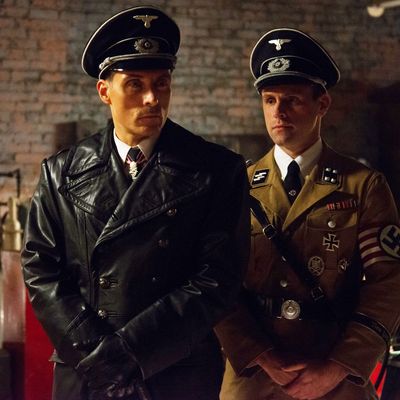
Based on Philip K. Dick’s novel, Amazon’s The Man in the High Castle is a period drama set in an alternate-universe version of 1962, in which the United States lost World War II and got carved up, with the Germans taking the East Coast, the Japanese the West, and the middle part of the country turning into a mostly ungoverned dystopia. The show arrives atop a tidal wave of hype, and it’s not the mind-boggling masterpiece that some advance reviews would have you believe. In the media, there’s a tendency to get so excited about changes in the TV industry — most recently, streaming services getting into the production business — that buzz can inflate evaluations of merit. I think that’s what happened here. The first set of episodes doesn’t capitalize on the show’s premise with the depth and thoroughness I’d hoped for, based on seeing a pilot earlier this year. Back then I wrote, “If nothing else, Castle is a superlative example of world-building, and if it makes it to series, it’ll be catnip to detail-obsessed nerds, who’ll spend countless hours parsing the differences between the show and its source material, and speculating on whether Dick’s account of how World War II ended up going the other way seems plausible even as a hypothetical.”
The series delivers something more straightforward and less subtle and thoughtful. It’s not Nazi Mad Men, where faux history is intertwined with the characterizations so that each informs the other, and you can spend hours talking about how, for instance, the middle part of the United States became a sort of Wild West, yet Hollywood continued to make bourgeois movies and turn Rock Hudson, to name one actor name-checked on the show, into a star. What it delivers is something more along the lines of Boardwalk Empire, where the main draw is suspense and bursts of gunfire and torture, undergirded by the low-level dread that comes from not being able to trust most of the characters when they tell you who they are and what side they’re loyal to, and wondering when, not if, the other shoe will drop.
Because the show officially premieres tomorrow, I’ll be vague here and revisit the whole thing at greater length later, when we’ve all had a chance to absorb it. For now, I’ll say that I can’t deny it’s engrossing, and that, like Boardwalk, even though I have a lot of problems with it and was disappointed by it a lot of the time, there was never a moment when I wasn’t gripped by the performances, the costumes, the production design, the photography, and the music. The production is overseen by longtime X-Files writer-producer Frank Spotnitz, who scripted most of the series. Judged purely as a physical, visual feat, the series is gorgeous — though often disquietingly so, considering how horribly many of the characters suffer. It’s both a genuine compliment and a backhanded one to say that you could watch The Man in the High Castle with the sound off and admire it as a series of moving paintings without knowing or caring about what’s happening in the story. Like so many series from Ridley Scott’s Scott Free Productions (which also makes The Good Wife), The Man in the High Castle is a genuinely cinematic TV series. It puts thought into what’s in the frame and what’s out, and the mix of movie genres represented in the visuals (not just the lavishly funded period epic and the spy thriller, but science fiction, film noir, and the Western) rarely fails to impress. Some of the East Coast scenes have the high-contrast menace of a German Expressionist horror film, the scenes in Japanese-dominated San Francisco make fine use of saltwater-mist-fogged light and jumbled, hilly storefronts, and the scenes set in the free territories evoke nasty ‘70s Westerns and the sorts of Coen Brothers crime thrillers where all the male characters wear hats.
Alexa Davalos plays Juliana Crain, a San Francisco woman whose sister is killed before her eyes by Japanese government police in San Francisco. With her dying breath, Juliana’s sister hands over reels of a film titled The Grasshopper Lies Heavy, which purports to show that the Allies actually won the war. Her boyfriend, Frank Frink (Rupert Evans), who keeps his Jewish heritage a secret for obvious reasons, thinks it was created by somebody known as the Man in the High Castle; Juliana learns that her sister was on a mission to deliver the film to Canon City, Colorado, in the “free zone,” and decides to finish the job. This brings her into contact with Joe Blake (Luke Kleintank), a young New Yorker who, when we meet him, joins the resistance to follow in the footsteps of his late father, a leader of the anti-German resistance.
There are double crosses and triple crosses, and people who pretend to be one thing and reveal themselves to be something else, only to reveal later on that the “something else” was just a ruse to convince their enemies that they weren’t actually the first thing. The intertwining plot strands are all of a type familiar to fans of traditional resistance-themed war thrillers: Will the rebels successfully assassinate an important visiting dignitary, or will the Powers That Be thwart them? Will that character that seems to be an ally of the good guys turn out to be a treacherous weasel working for the Germans or the Japanese? There are so many reversals of expectation that after a while they cease to have much impact; in time, they have the perverse effect of making you appreciate characters who are consistently defined by just one or two traits— such as the Marshal (Game of Thrones’ Burn Gorman), a cowboy-styled bounty hunter who hisses his lines in the manner of early Clint Eastwood and exists mainly for the pleasure of scaring and killing whoever happens to be on his list of targets.
Intrigue is the main reason to watch The Man in the High Castle, and by the time you get to the third episode, which divides its action between Canon City and a San Francisco torture facility where [character name redacted] is being interrogated, you might feel as though you’ve stumbled into the continuation of 1983 World War II–inflected science-fiction series V, which (in both the original and the remake) was ultimately more interested in who’s doing what to whom and why than it was in lingering in the sociohistorical nooks and crannies of its alternate universe.
The most vivid touches, such as the anti-Semitic graffiti glimpsed on an old Marx Bros. poster and the inclusion of Billie Holiday’s classic anti-lynching song “Strange Fruit” on the soundtrack, suggest that the show is more of a satire or allegory than it’s really interested in being. Some of the most effective moments involve the interaction of once-dominant classes of Americans (straight, white Christians, mainly) and members of groups that were only slightly less despised here than they were by Germans or Japanese (particularly African-Americans and Jews). Here and there you get the sense that The Man in the High Castle is building toward becoming a Twilight Zone–style fable or cautionary tale that shows characters who were once sitting pretty what it means to live in a culture that considers them pariahs or vermin and barely tolerates their existence. But such moments are fleeting. We get an image here, a line there, and it’s back to the plotting and whacking. And there are moments when some of the historically or racially explosive situations (such as the use of Zyklon B by Nazi torturers against Jews, or the many shots of sadistic Japanese guards brutalizing Yankees) are not handled with as much care as they should have been.
The performances are superb; best in show probably goes to Rufus Sewell, who plays an SS officer assigned to disrupt and destroy the Reich’s enemies by any means necessary. Sewell freezes his handsomely chiseled face into a mask of secrecy and slightly bland ruthlessness and proves to be quite the badass when the resistance tries to kill him in a crossfire. Another standout is Cary Hiroyuki-Tagawa, who manages to suggest a rich inner life as Nobusuke Tagomi, a Trade Minister of the Pacific States of America. The casting is very clever in how it plays on our previous knowledge of the bigger-name actors’ careers. When American viewers see Hiroyuki-Tagawa, they’ll think of all the stereotypical sinister Asian roles he’s been cast in over the years and expect more of the same, then be confounded by the thoughtful and sympathetic notes he strikes, then wonder if they aren’t just there to throw us off the narrative trail and set us up for nasty confirmation of our suspicions. At its best, The Man in the High Castle is an epic thriller organized around the idea that life itself is a sustained performance, by individuals and entire civilizations.





